Don’t we all have a better half, family members, friends or acquaintances with whom we want to share awesome experiences or introduce to a new way of riding but can’t? New, knobbly-tired step-through eMTBs make getting on and off the bike a lot easier, instilling beginners with confidence and opening up new opportunities.
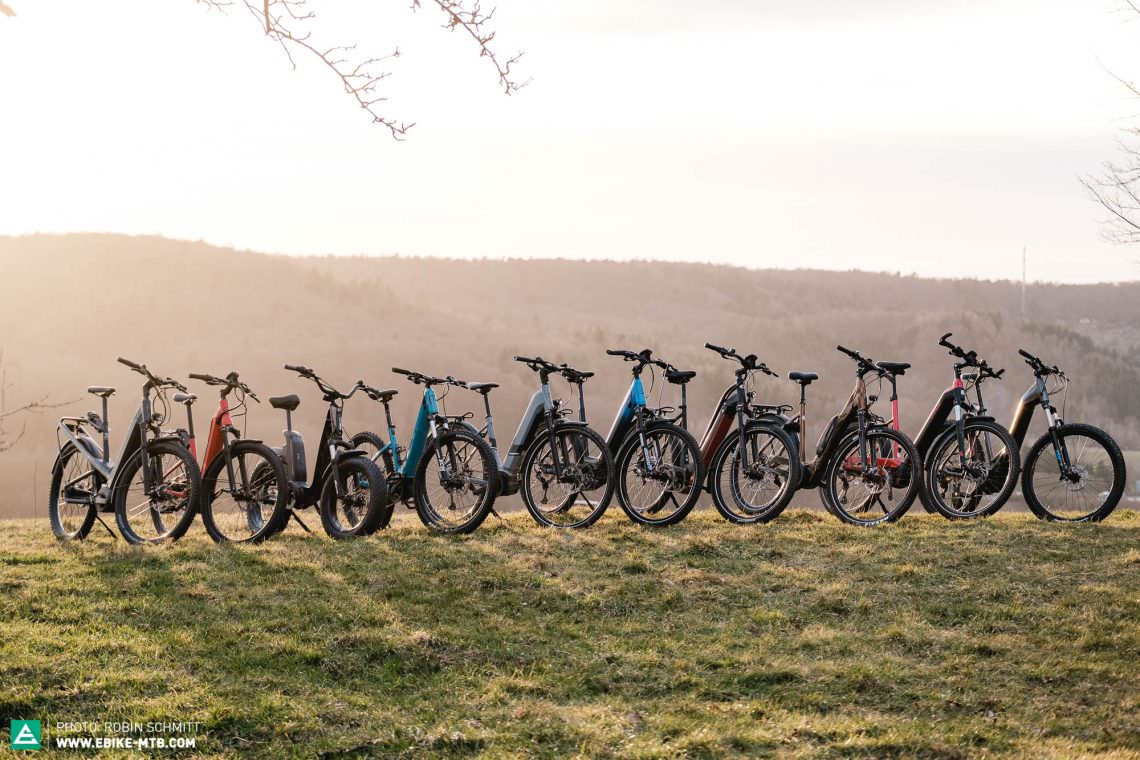
Table of contents
- The test field
- The test riders
- Which step-through eMTB has the longest range?
- What to look for in a step-through eMTB?
- The best step-through eMTB of 2020
Modern off-road step-through bikes are revolutionary and sales figures are going through the roof, at least in German dealerships. Rightly so, because they unite generations like no other bike, are super versatile and true masterpieces of modern engineering. Handling like a hardtail without a top tube is no small feat. One thing we can say for sure is that only a handful of manufacturers have gotten it right, especially while keeping the weight to a minimum and the design looking good.
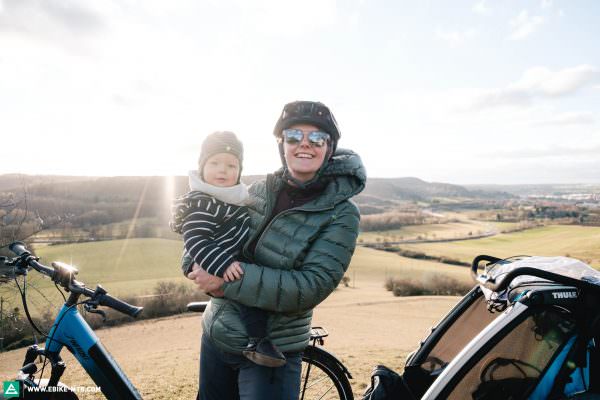
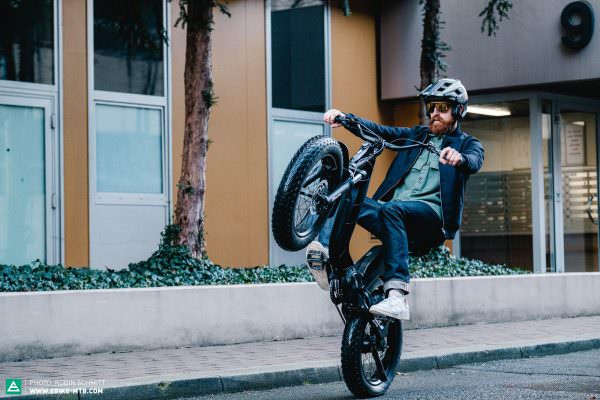
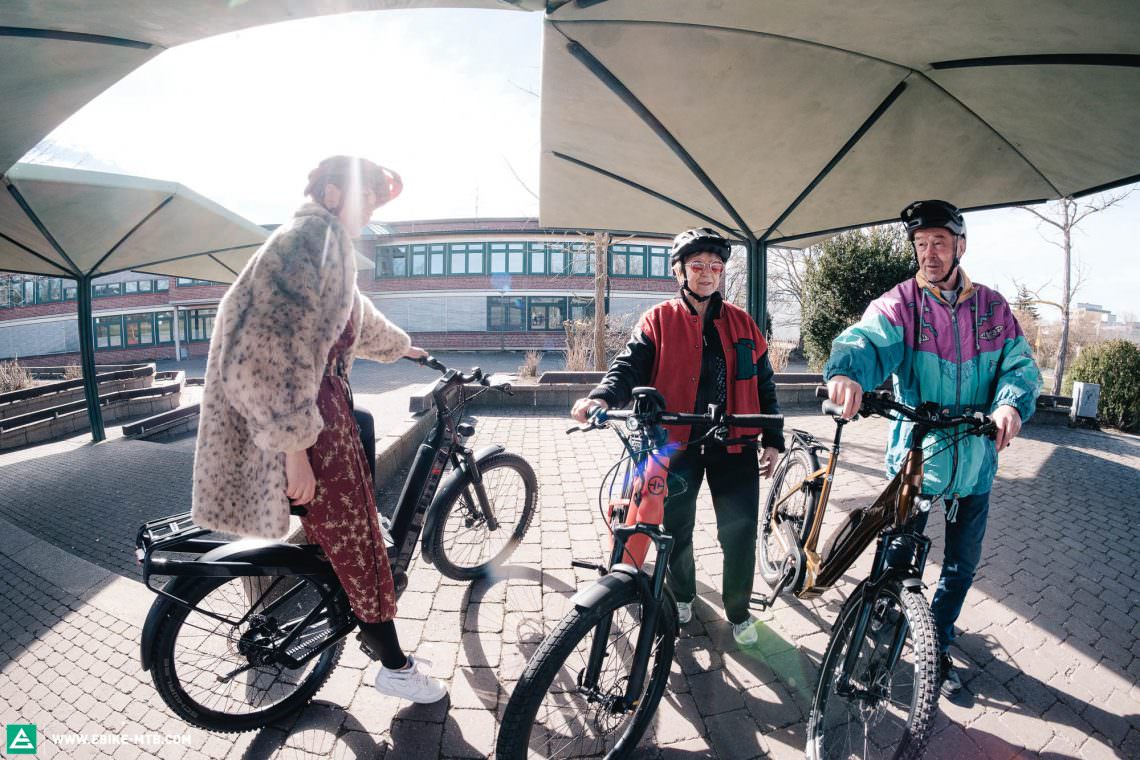
We invited our grandparents, friends (both with and without injuries, and with and without babies), daughters, fathers and mothers to test ten of the latest generation step-through eMTBs with us! We found out what it really comes down to with this type of bike and which model is best for which purpose.
It’s definitely worth taking a closer look at step-through eMTBs, because they can change lives or at the very least quality of life – either your own, that of your partner, your family or your acquaintances!
Step-through bikes help bridge the generational divide. Whether it’s a knobbly-tired city cruiser, pack mule for extensive tours or simply a machine to have fun on, you’ll find a suitable model for almost every application.
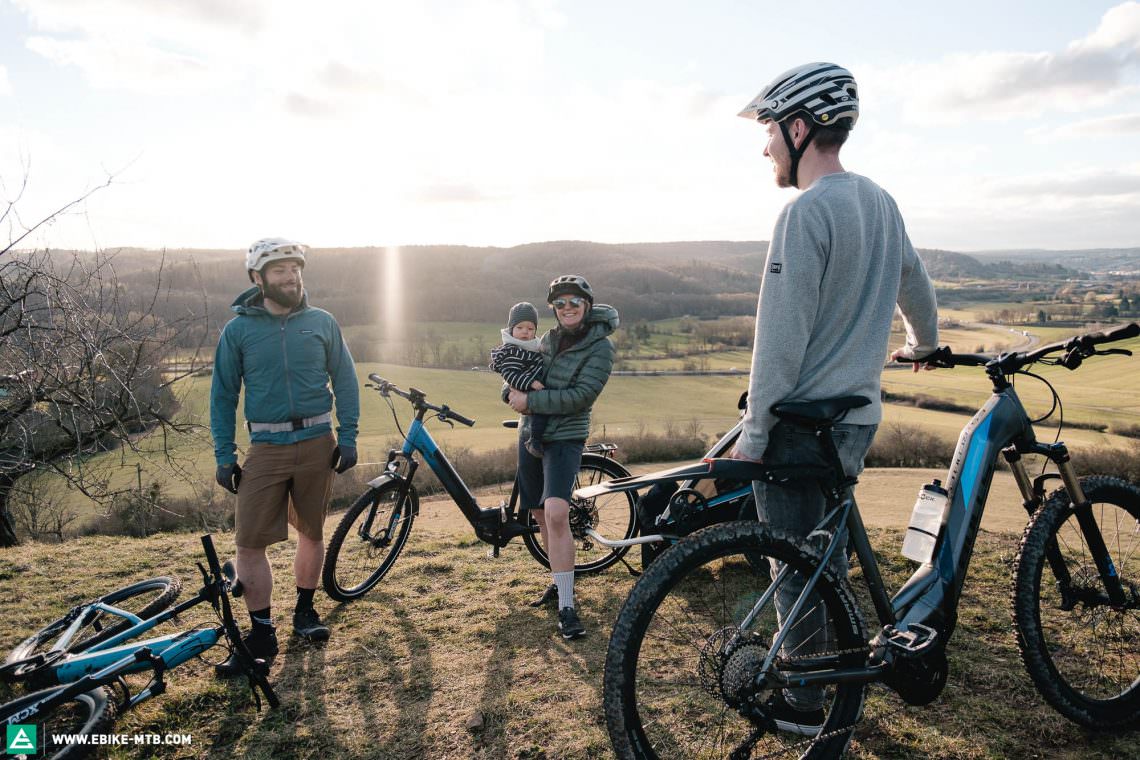
What does a good step-through eMTB have to be capable of?
Designing and engineering a good off-road step-through bike isn’t easy, whether it’s for touring, off-road or city use. After all, it should deliver similar stiffness and comfort levels as any other bike even with the rear rack loaded despite its lack of a top tube. At the same time, integrating the battery into the down tube, for a sleeker design and minimal weight takes some skilful engineering. If the frame isn’t stiff enough, it results in speed wobble and spongy handling. This means that even small bumps have the potential to upset the bike, making it a hazard to ride, which is only exacerbated if you load up the rear rack. The good news is that the best models can do all that a bike with a top tube can and more! They’re often more comfortable, easier to get on and off and they instil you with more confidence. Newcomers to the sport and less flexible riders benefit enormously from the upright riding position and the easy access step-through design. The riding position of most step-through eMTBs also ensures that you’ll never feel like you might go over the bars, even when you’re pushing the limit.
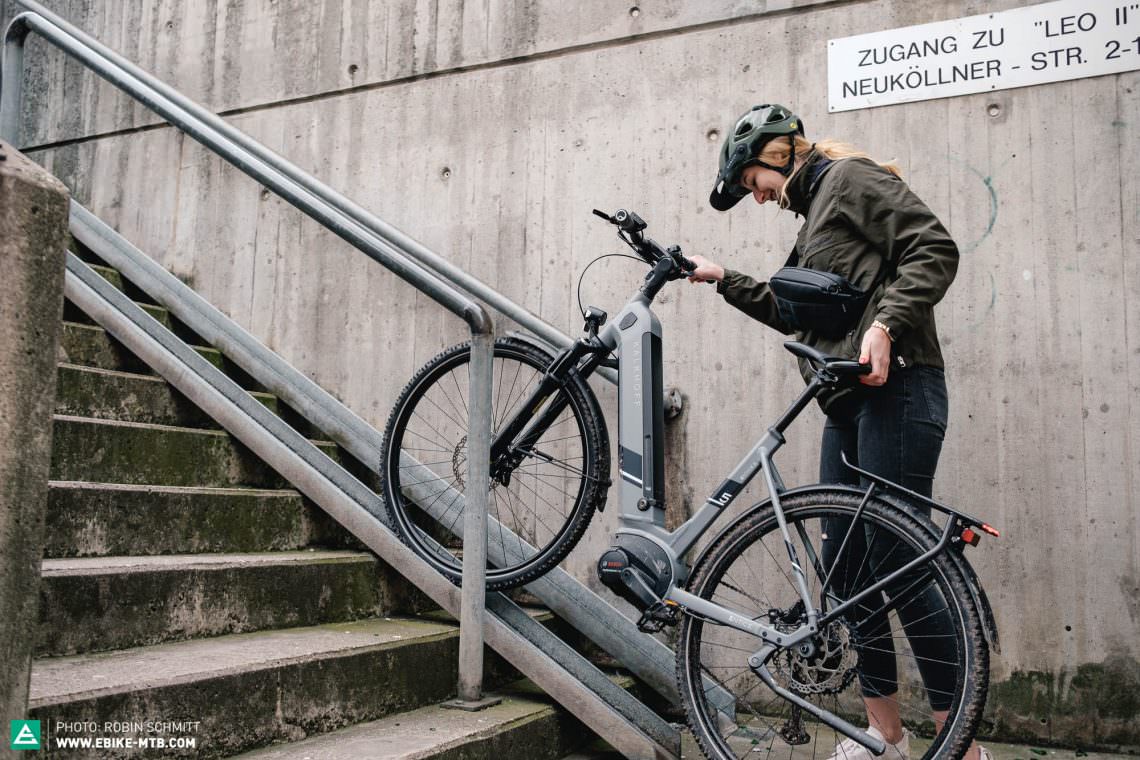
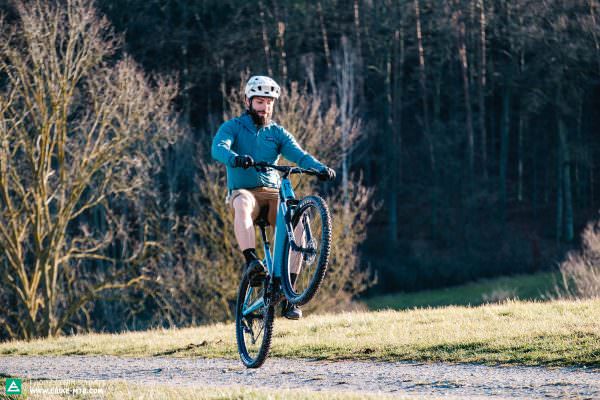
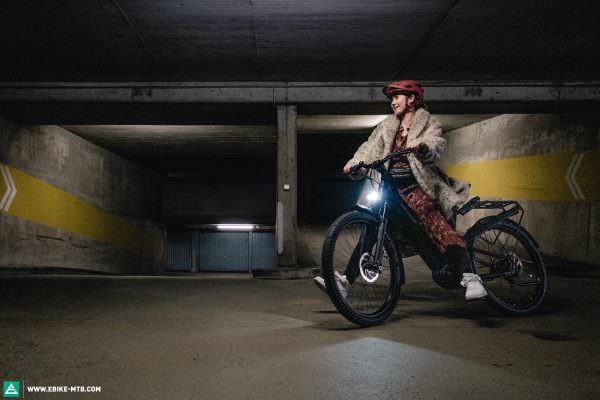
Forget the cliché that step-through bikes are only for grandmas! The latest generation of off-road step-through bikes can take on rides through the woods on moderate trails while also offering everyday practicality in the urban jungle. A good step-through eMTB will put a smile on the face of everyone who rides it, whether on moderate terrain, commuting or loaded up with panniers for long weekend tours. To do so, it has to be simultaneously composed and agile and be versatile enough to perform equally well on different kinds of terrain. Ideally, the handling has to be predictable and forgiving yet also precise, regardless of whether you’re riding uphill, on level terrain or down a steep descent. Powerful, reliable and easy to modulate brakes as well as good tires that provide grip on different surfaces weather conditions are essential. The quality of components such as lights, racks, mudguards and stands is extremely important and should match your intended use. Most step-through bikes offer a high maximum payload for the rider and their gear and are approved to pull a trailer. Ideally, they also come equipped with a GPS tracker to track and recover the eMTB in the event of a theft, for peace of mind when leaving it at the train station.
You think step-through bikes are ladies’ bikes, only for grandmas? We see it this way: a good step-through eMTB can tackle rides through the woods on moderate trails, offer everyday practicality in the urban jungle and instil you with confidence.
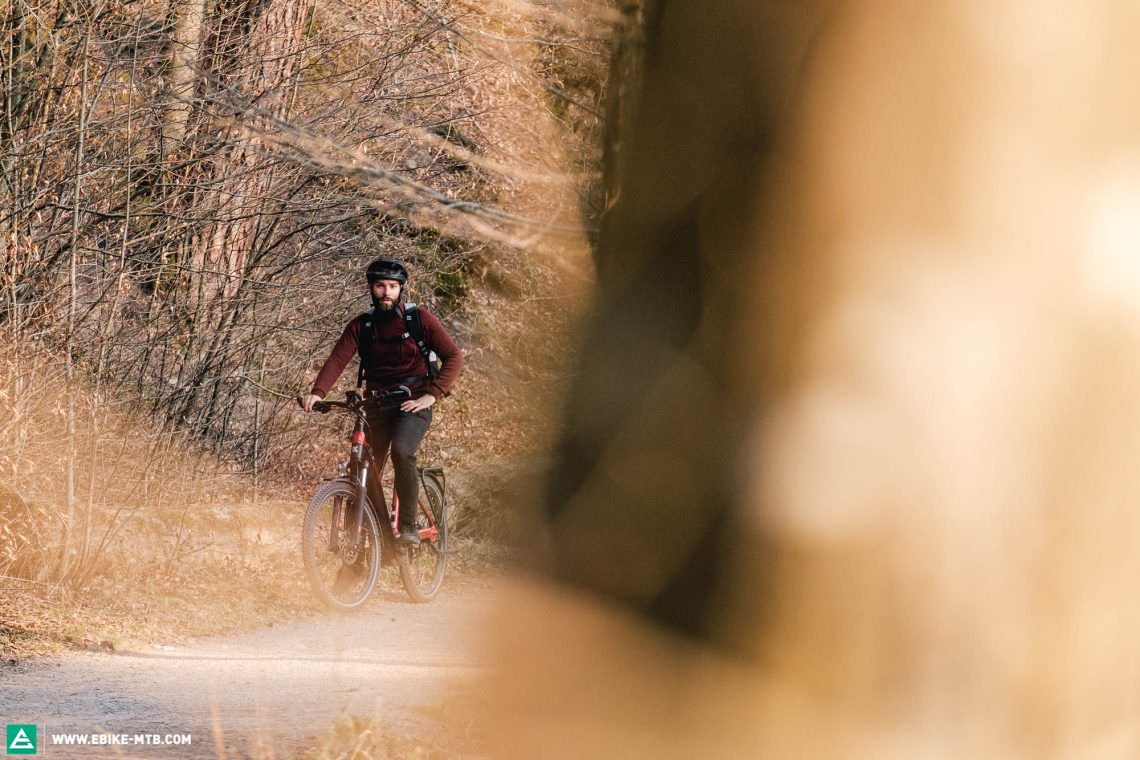
Far more than comfort bikes, step-through eMTBs have a huge target group: including you?
The days when step-through bikes were called women’s bikes are over! Newcomers of all ages can benefit from the upright riding position, the increased confidence and the easy mounting and dismounting. Step-through bikes simply make it possible to experience more together. If you’re injured, you’ve got limited physical flexibility, you’re ageing or suffering from some form of disability but don’t want to give up the best hobby in the world, a step-through eMTB is exactly what you need. Of course, you’re welcome to ride a step-through bike simply because you like the unconventional look or have fun trying out new things. Finally, for the lazy couch potatoes who don’t feel like lifting their leg over the top tube – what a chore – this new generation of eMTBs is great! If you’re looking for an easy handling bike for moderate terrain, extended tours and everyday life, then a good step-through eMTB is the answer you were looking for.


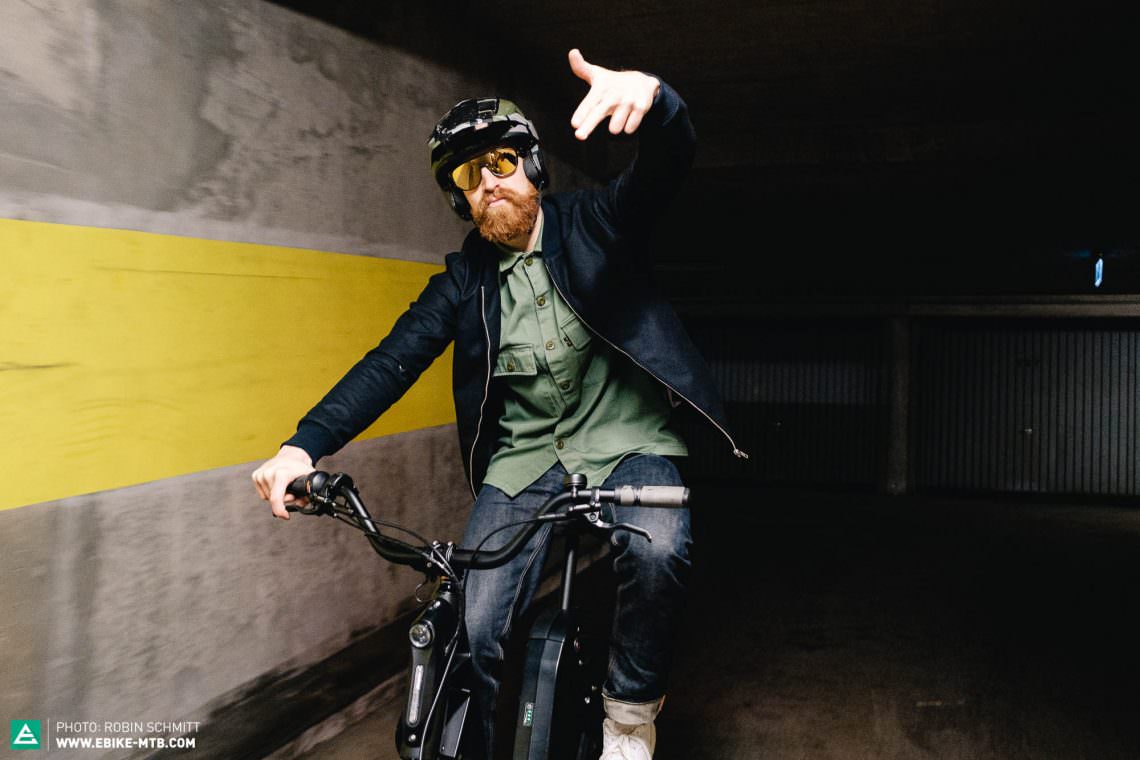
I want to carry my luggage, what should I look for?
Those who want to go on extensive tours and weekend trips, or commute to work or do their weekly shopping on their step-through eMTB will definitely need to use a rack. This brings us back to the subject of torsional stiffness. Stable and composed handling without dangerous speed wobble are a basic prerequisite when you’re hauling cargo. This comes down to the stiffness of the frame, balanced weight distribution, but also the system as a whole. A stiff frame is only as good as the components on it. With additional weight on a loaded rack, the centre of gravity is shifted backwards, putting handling to the test. Unfortunately, direct and precise steering isn’t the norm and the handling of the bike tends to suffer.
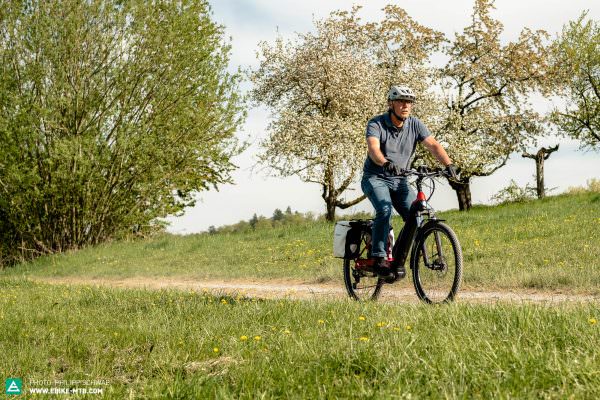
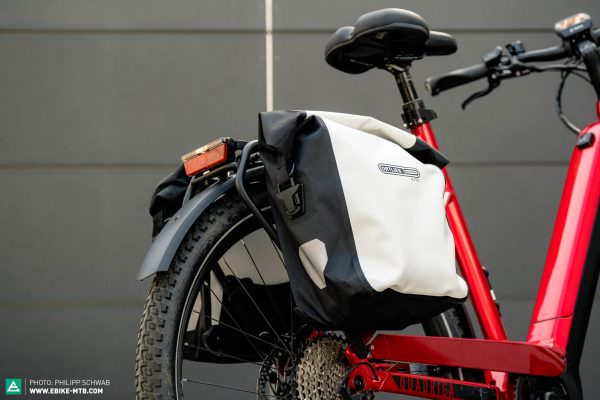
Stable and composed handling without encountering speed-wobbles are especially important when you’re carrying luggage. A torsionally stiff frame and an even weight distribution are a basic requirement.
What if you prefer using a front rack or a basket on the bars? This also influences the handling, though the payload is usually limited to a few kilograms, just enough to buy a few things at the market. This can be a sensible alternative to comfortably transport lightweight goods over short distances, but if you want to haul your luggage on a step-through eMTB without having to wear a backpack, then a rear rack makes the most sense. To find out how they handled, we filled two panniers to 11 kg, corresponding to 22 large beer cans, and tested the step-through eMTBs that came equipped with a rack. On some models, it felt like we were drunk, zigzagging along without any control (we promise we didn’t touch the beers). To hold your line, a lot of input was required at the bars to counter-steer against the weight of the bike. There’s still plenty of room for improvement here.
In contrast, CENTURION and Riese & Müller show how it’s done. The handling of these bikes stays almost the same with a fully loaded rack. On the full-suspension Riese & Müller, the weight on the rack even forms part of the sprung mass, which protects your cargo from sudden impacts and also improves the bike’s stability. Many bikes in the test field can’t keep up here though they’re able to cope with the demands of a little added weight. For example, the Corratec Life CX 6X Connect clearly can’t handle an 11 kg load and is overworked when you load it up.
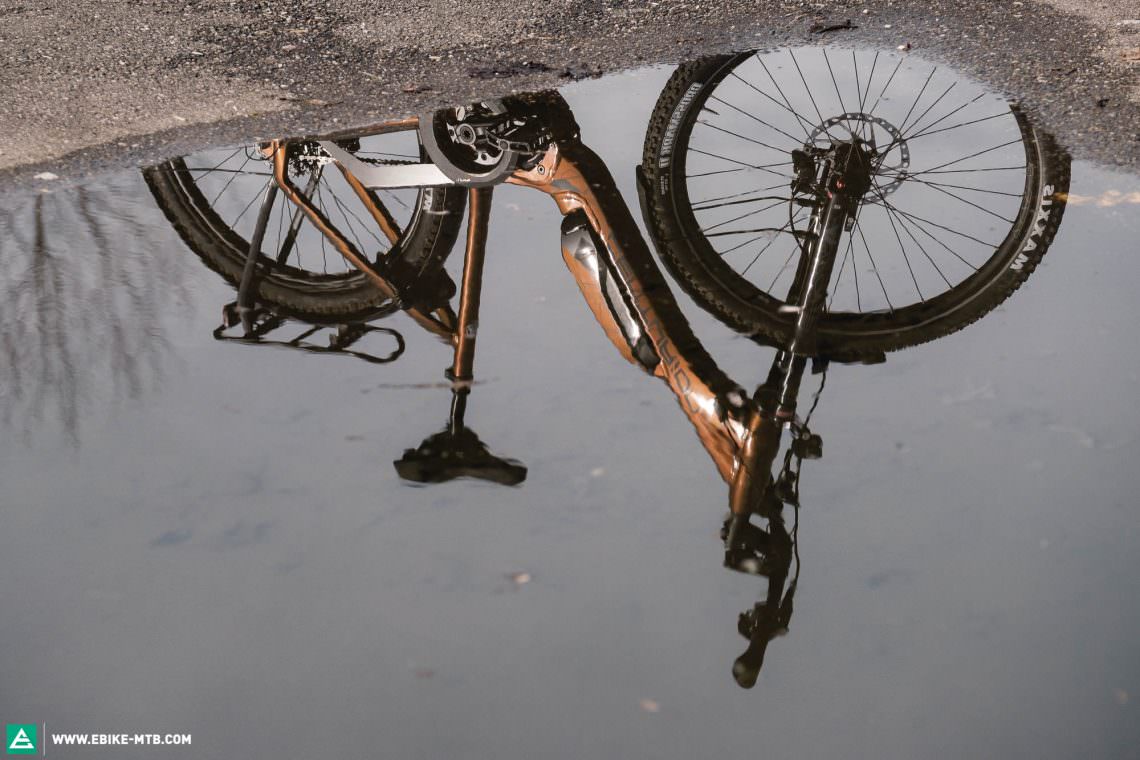
The test field
There is a huge choice of step-through bikes on the market, but if you look closely, it soon becomes clear that not all have the potential to be a good step-through eMTB. Once you eliminate the bikes with a high centre of gravity due to the position of the battery, inadequate components, slick tires and vague handling, you’re left only with a handful of models to choose from. That said, there are some standout models among them, providing opportunities for newcomers to the sport to make the most of their first eMTB experience. From sporty models for light trail use such as the BULLS or the Moustache, to bikes such as the Riese & Müller, which play to their strengths on extensive tours with luggage, to knobbly-tired city cruisers such as the Kalkhoff or HNF-NICOLAI, there are great step-through eMTBs on the market for every scenario. For us, one thing was clear from the start: we were looking for the best all-rounder that combines excellent handling with a good spec and can excel in moderate terrain, on extended tours with luggage and in everyday life. We found ten hot candidates in this burgeoning market. Unfortunately CUBE were unable to provide us with a suitable bike at the time of testing. Too bad, as we had been very excited to see how the FOX 34 fork performs on the CUBE Nuride Hybrid SL step-through eMTB.
| Bike | Price | Weight | Motor/Battery | Everyday accessories |
|---|---|---|---|---|
| BULLS E-STREAM EVO 1 WAVE 27,5+ (Click for review) | € 3,599 | 23.80 kg | Brose Drive S Mag 90 Nm 750 Wh |
no |
| CENTURION E-Fire Country F3500 (Click for review) | € 3,999 | 23.70 kg | Shimano STEPS E8000 70 Nm 504 Wh |
yes |
| Corratec Life CX 6X Connect (Click for review) | € 3,999 | 25.90 kg | Bosch Performance Line CX 75 Nm 625 Wh |
yes |
| FANTIC ISSIMO FUN (Click for review) | € 2,995 | 33.40 kg | Bafang M500 80 Nm 630 Wh |
partially |
| HNF-NICOLAI UD 3 (Click for review) | € 4,695 | 27.90 kg | Bosch Performance Line CX 75 Nm 625 Wh |
yes |
| INFRONT IF-4 Wave (Click for review) | € 3,599 | 27.10 kg | Bosch Performance Line CX 75 Nm /625 Wh |
yes |
| Kalkhoff Entice 5.B Excite (Click for review) | € 3,799 | 24.80 kg | Bosch Performance Line 65 Nm 625 Wh |
yes |
| KETTLER QUADRIGA TOWN & COUNTRY COMP (Click for review) | € 3,799 | 28.70 kg | Bosch Performance Line CX 75 Nm 500 Wh |
yes |
| Moustache Samedi 27 Off 2 Open (Click for review) | € 2,899 | 22.90 kg | Bosch Performance Line 65 Nm 500 Wh |
no |
| Riese & Müller Homage GT (Click for review) | € 6,499 | 29.70 kg | Bosch Performance Line CX 75 Nm 500 Wh |
yes |
| Ø € 3,868 | Ø 26.80 kg |
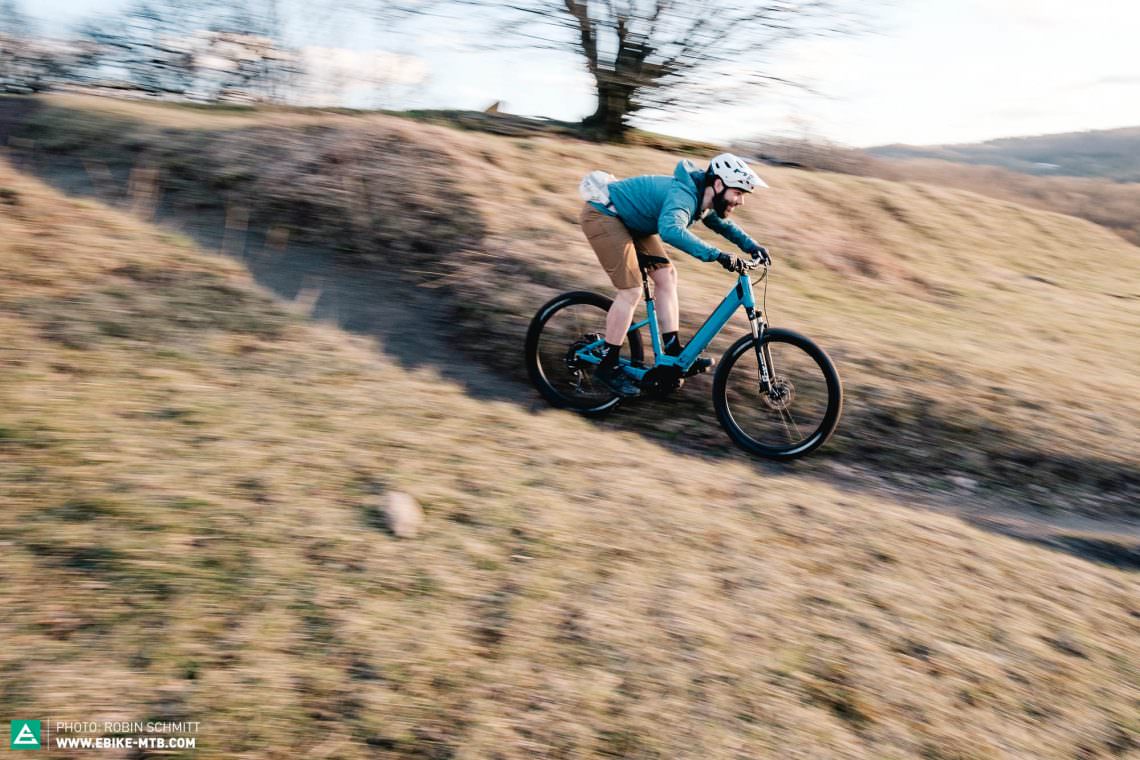
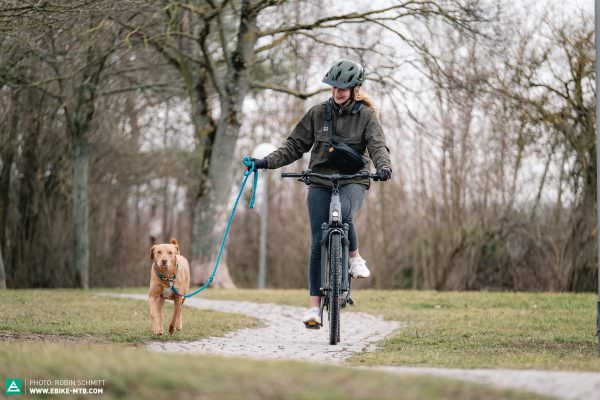
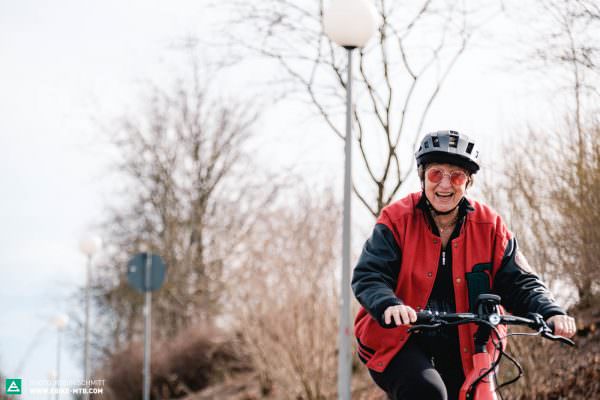

The test riders and what they expect from the latest generation of off-road step-through ebikes
Our test team is as diverse as the step-through eMTBs they tested. Pensioners, eMTB newcomers, commuters, connoisseurs, athletes and sceptics. The youngest test rider is 20, the oldest 83 years old. The testers and their demands on the bikes could hardly be more different, yet everyone had a lot of fun, especially when riding together. It’s true, step-through bikes bring people together – not just across generations, but also skill levels.

As an eMTB newbie, a bike with easy, good-natured and predictable handling is extremely important to me. I want a bike that instils me with confidence and offers lots of comfort on relaxed tours and while commuting. The KETTLER is my favourite.
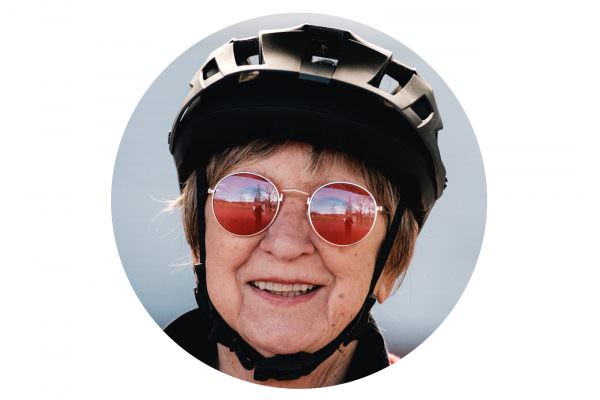
I rode a bicycle again for the first time after crashing a year and a half ago. The HNF-NICOLAI was a lot of fun and I had a great time on it. It’s true, joy shared is joy multiplied!
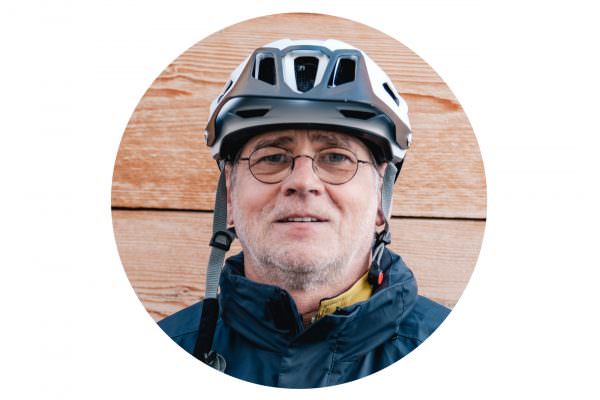
A motorcycle accident ruined my knee years ago, making it very difficult for me to swing my leg over the top tube of an eMTB. Step-through eMTBs are the only way for me to pursue my hobby. My favourite is the INFRONT!

Do you want to know the feeling of putting a smile on the faces of your friends, acquaintances or family? Of sharing moments with your loved ones who haven’t yet experienced freedom on two wheels? Step-through eMTBs open up new possibilities! Personally, I wouldn’t ride one, but many of the amazing people surrounding me would. I look forward to seeing how this new category of bikes will develop in the coming years!
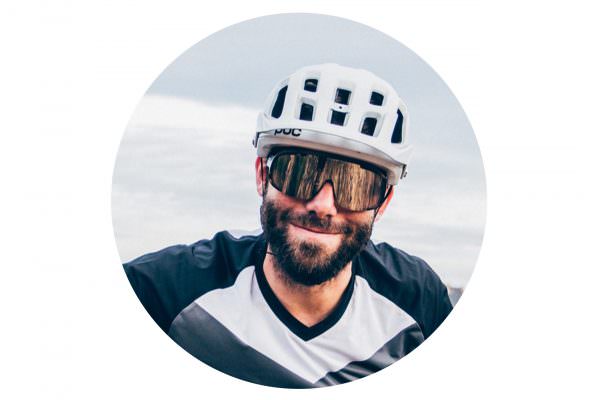
Admittedly, I was sceptical at first. However, I have to admit that I was pleasantly surprised by most of the step-through ebikes on test. Their handling is largely intuitive and some models are a lot fun! I wouldn’t buy one, it’s just not my thing, but for my mum the HNF-NICOLAI would be the perfect ebike.

I commute a lot on eMTBs, sometimes on moderate trails, sometimes on bike paths. Integrated lights, a comfortable riding position and the feel of the motor at the 25 km/h threshold are just as important to me as the handling when I want to ride fast off road!
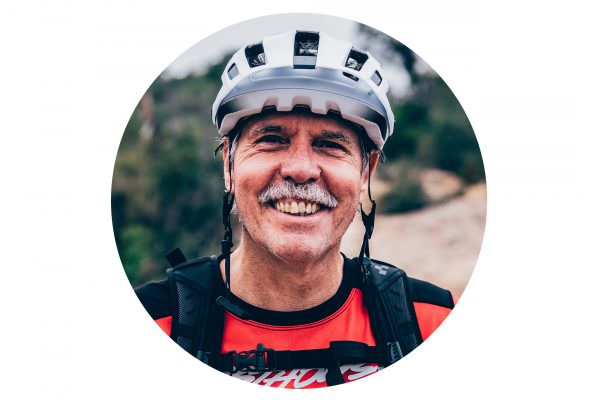
I use an eMTB to commute and to tow my dog trailer – my dog Henry doesn’t like being left at home when I head into the E-MOUNTAINBIKE office. Almost all step-through eMTBs are approved to pull a trailer, which is good for me and many young families. If I’m riding with my buddies without a trailer, I want a good-natured and comfortable bike. The CENTURION is just my thing!

Cruising through the hood – it’s what the FANTIC is made for. Unfortunately, it’s as awkward and impractical as running errands in a supercar. A replacement for a Vespa? Perhaps.
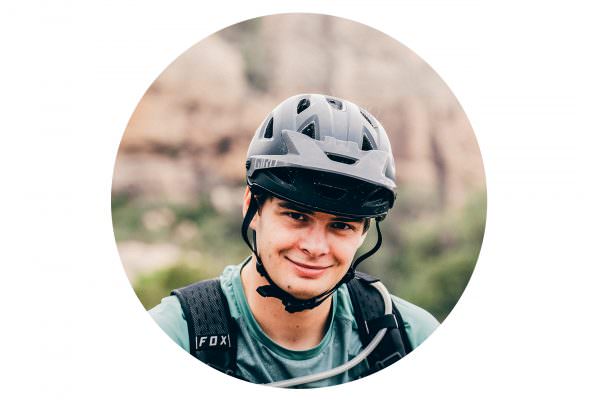
No question, I would never buy one of these bikes for myself, but the BULLS is surprisingly capable on the trails. There is a lot of potential in this step-through eMTB! It’s a shame that none of the models come with higher performance forks.

For me, easy handling and a safe ride even with my luggage are very important. I don’t like carrying around a backpack. My favourite is the CENTURION. Along with the generous step-through section, the dropper seat post makes getting on and off the bike even easier.

I usually only use ebikes for day-to-day stuff and occasionally go moderately off road. I have to charge the battery in my apartment and park the bike in the basement. Therefore, an easily removable battery and a light bike are super important to me. Many bikes in the test are simply too heavy. I liked the agile Moustache and would be willing to retrofit the missing accessories.

I ride everything that has two wheels. From enduro bikes to road bikes, I enjoy it all. As a father, I see the advantage of a comfortable step-through eMTB, especially when taking my son to nursery school in his trailer or going on a tour with the whole family. I don’t care if people call it a grandma bike.
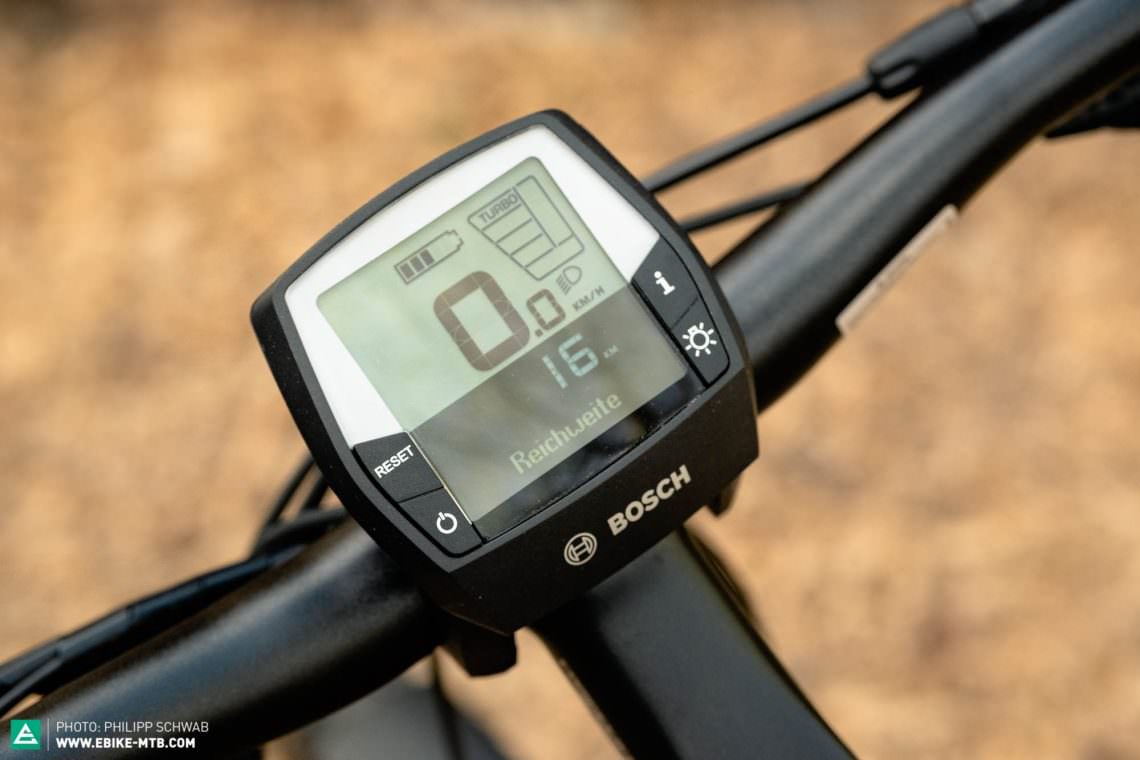
Which step-through eMTB has the longest range?
Most people will already know that there is no easy answer to this question. The range depends on many other variables besides the battery capacity. The tires, tire pressure, outside temperature, support level, route elevation profile and rider weight are just some of the factors that influence how far you can ride your step-through eMTB on a single charge. You can end up anywhere between 10 and 100 km, meaning that definitive claims are out of place and misleading. Besides, more isn’t always better. More battery capacity inevitably leads to more weight, affecting weight distribution and usually creating a higher centre of gravity and thus compromising the bike’s handling and suitability for everyday use. Our motto is: as much as necessary, but as little as possible. Think carefully about how much battery capacity you really need. If you prefer long weekend tours, a dual-battery system is useful, which, in our test field, is only available as an option on the Riese & Müller. Alternatively, you could use a quick charger during your lunch break. If you only commute short distances, 500 Wh is usually sufficient. Can you get your bike close to a power outlet? Or do you have to remove the battery to charge it? In that case, an easily removable battery is usually more important than a few additional watt-hours.
The tires, tire pressure, outside temperature, support level, route elevation profile and rider weight are just some of the factors that influence how far you can ride your step-through eMTB on a single charge.
What to look for in a step-through eMTB?
Componentry, accessories, workmanship and technical features are important factors but bear in mind that the usefulness of expensive high-tech equipment on an off-road step-through bike depends heavily on how you intend to use it. Before buying, you should think about what you want to get out of a step-through eMTB, what it should be capable of and where you’re usually going to ride it. Are you looking to replace your family van with a bike trailer for the kids, or maybe you want a commuter, or an electronically-assisted, knobbly-tired shopping cart, or a fair-weather fun machine for moderate terrain? Do you share the bike with the whole family? Which features make sense for you and which unnecessarily drive up the price? The following sections are intended to help guide you in choosing the right bike.
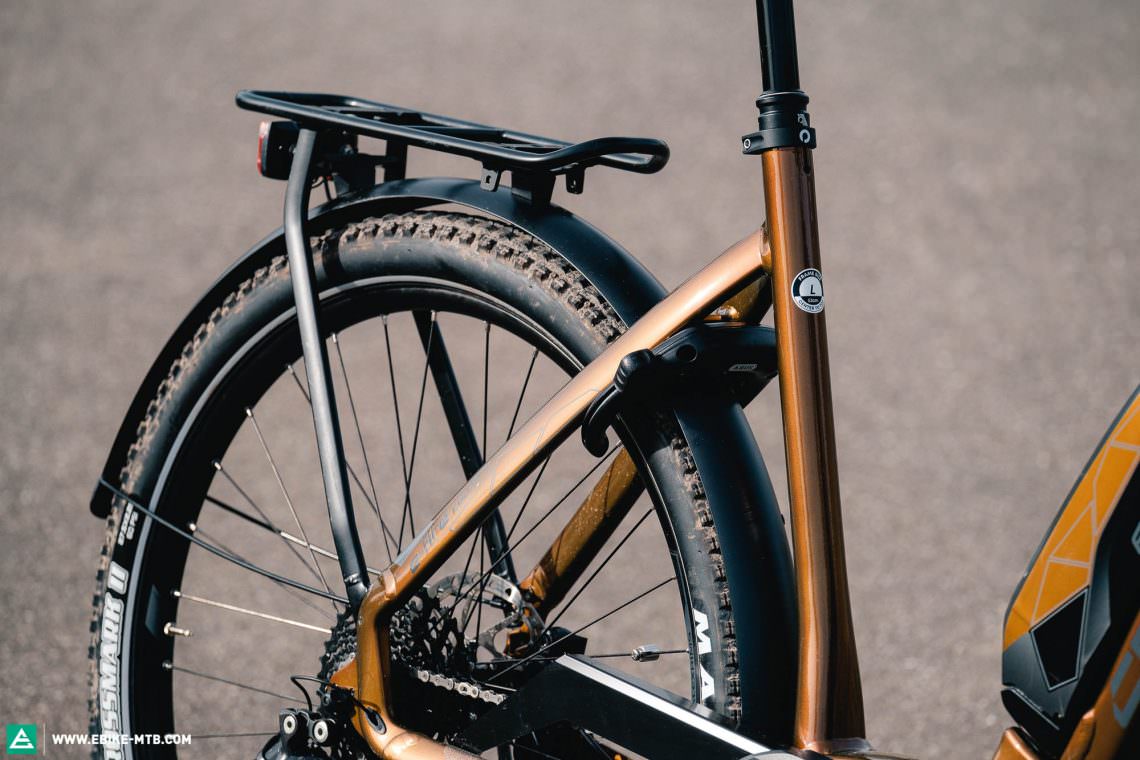
Everyday practicality
A step-through bike has to be versatile and mudguards, a side stand and pannier rack greatly improve its everyday practicality. Most brands deliver their models equipped with all these accessories as standard. Two bikes in the test field (BULLS and Moustache) come without mudguards, lights, a rack or a side stand, though you can retrofit them to make the bikes more practical for everyday use. Our tip: in most cases, the brands themselves have these accessories on offer, so you can get them in the same order with your bike. Besides ensuring that the accessories will fit, they’ll also match the look of the bike. The bike’s look and function often suffer if you resort to homemade and aftermarket accessories.
Battery removal and the position of the charging port
For those who can’t or don’t want to charge the battery in the bike, removing the battery out of the top of the frame is the most convenient. You can also charge the battery on the bike and the positioning of the charging port will be a matter of taste: if it is positioned low down, such as on the KETTLER, you have to bend down to reach it. With the Kalkhoff, for example, it is positioned high up but as a result you’ll have to find somewhere to rest the charger or let it dangle in the air.
Regarding quality, Bosch’s standard cover for the charging port looks cheap, breaks easily and gets lost. On the four bikes in our group test with this cover, it also tore off on all of them. This is problematic when you ride in bad weather and run the risk of clogging the charging port up with mud. Kalkhoff, KETTLER and Moustache have recognised the problem, all of them supplying their Bosch equipped bikes with their own in-house covers. The Brose Drive S Mag on the BULLS even features a fully functional magnetic cover – that’s how we like it!
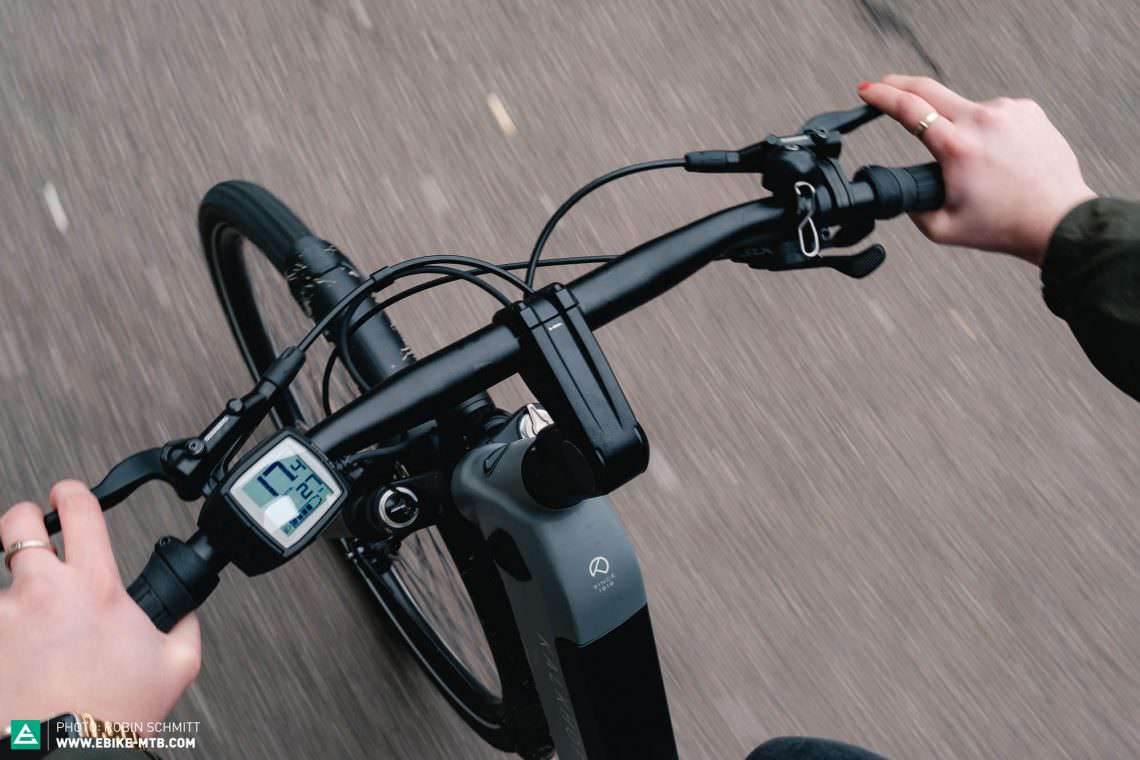
Brakes
As with performance oriented eMTBs, we recommend reliable and powerful brakes. Although you won’t blast down the craziest trails and steepest gradients on a step-through eMTB, you still want to be able to stop reliably, quickly and safely in city traffic. Some brands have started to pay more attention to the maximum payload of the bikes but then forget to spec the appropriate brakes needed to cope with the additional weight. The best brakes in the test are easy to modulate with one or, in case you get a scare, two fingers, while still providing sufficient stopping power even after long descents. High-performance brakes such as the CODE RSC or MAGURA MT5 aren’t out of place on a step-through bike. On the contrary, they increase rider safety. With the exception of the INFRONT, the brakes in the test are too weak and they’re not reliable enough to take on long and steep descents while hauling luggage – most brands still have a lot of catching up to do here.
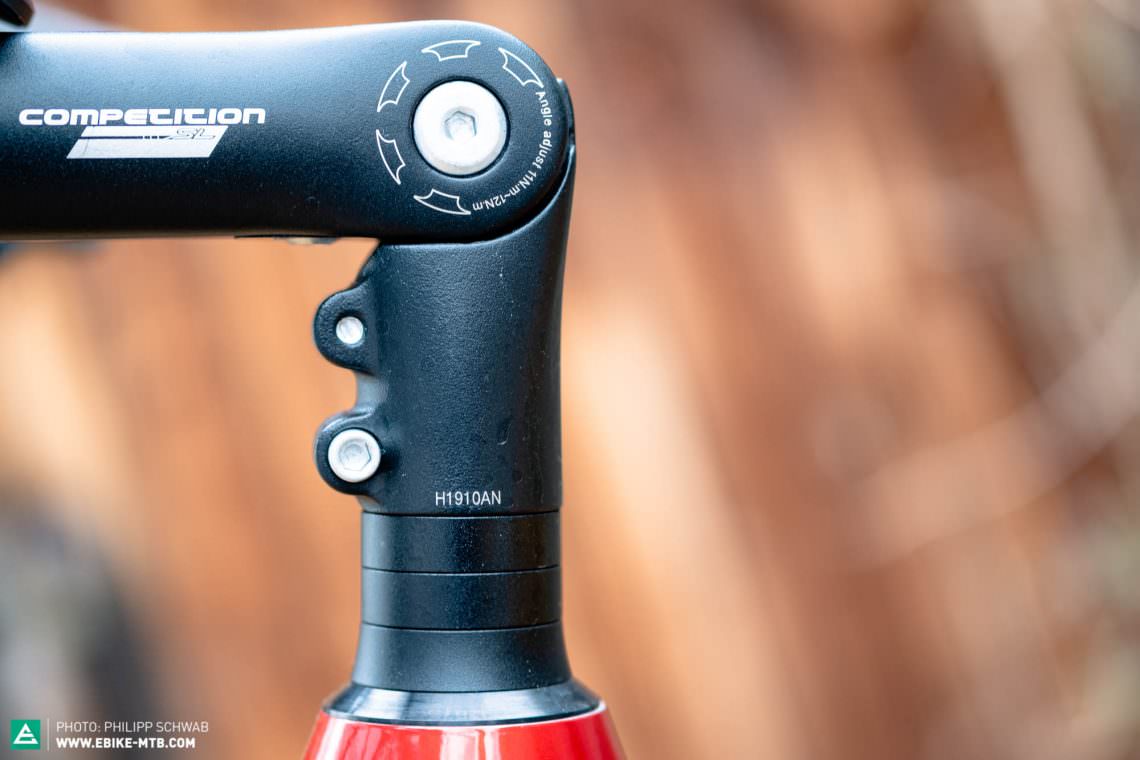
Ergonomics
Many brands claim to spec their bikes with the most ergonomic components. The problem here is that every person is different, with their own preferences and riding styles which only becomes more obvious given the bikes’ versatility. Contact points such as the saddle and grips of an eMTB should always be individually adjusted to suit the rider and the type of riding they do. If you plan on regularly hitting the trails on your step-through eMTB, a wide touring saddle won’t do! Besides looking a little silly, it severely restricts your freedom of movement, robbing you of confidence and fun. Contrary to what you might expect, a super wide and well-padded saddle isn’t always more comfortable than a narrow and firm saddle. It can only really be comfortable if it suits your anatomy, your riding position and your weight. A good dealership should have all the devices and expertise needed to help you find the right saddle for your needs. For example, INFRONT in Germany will help you find the correct width SQlab saddle and right thickness SQlab grips with their fitting kit. It’s always a good idea to discuss the contact points in person, whether it’s at the headquarters of the small bike brand in Germany or your local dealership.
Many trekking-oriented bikes in the test field come specced with an adjustable stem. Ideally, this allows you to finely adjust riding position anywhere between aggressive and upright. Almost everyone should find their preferred riding position. If you do adjust the stem, be sure to use the right torque settings when you tighten the bolts!

Suspension
Coil or air fork? We wholeheartedly recommend air forks here. Coil shocks usually require less maintenance, but they can’t be adjusted accurately enough to suit the weight of the rider – you’re either too light or too heavy, entirely voiding the benefits a fork would otherwise give you. But beware, even air forks are limited in their adjustability. Some manufacturers give their bikes a maximum payload rating that goes well beyond the sensible adjustment range of the fork. For example, the Corratec Life CX 6X Connect is approved for a maximum payload of 154 kg, but the suspension fork can only be adjusted up to 130 kg – a clear case of speccing a bike with inappropriate componentry.
There are marked differences regarding performance too. In moderate terrain, a bad fork will limit the capabilities of a step-through eMTB, which is the case with the BULLS E-STREAM EVO 1 Wave 27.5. In future, we’re hoping to see high-end, high-performance forks on trail-oriented step-through eMTBs. The INFRONT is the only bike in the test field that came specced with a truly capable suspension fork. Another highlight is the Homage by Riese & Müller, which is the only full-suspension step-through eMTB currently on the market – comfort bike 2.0!
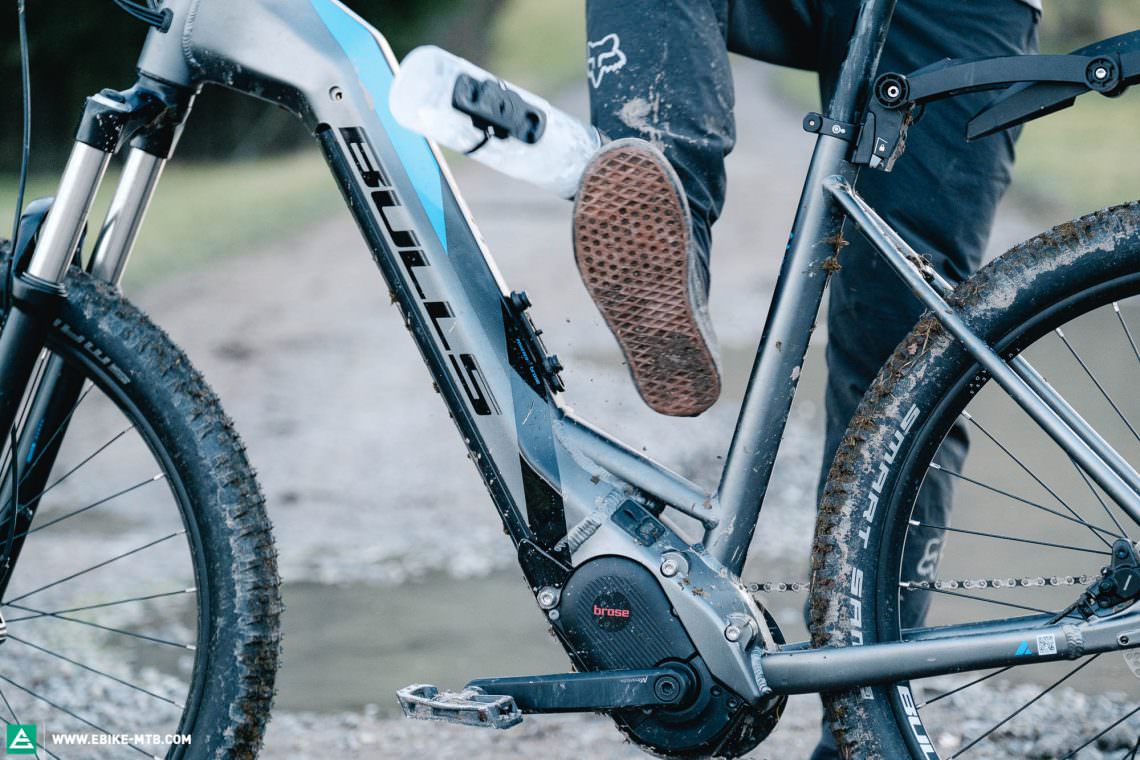
The position of the bottle cage
If the bottle cage is positioned near the step-through section of the frame, it usually gets in the way and the concept of the step-through eMTB is rendered useless. It results in you having to lift your leg almost as high as you would with an eMTB that has a top tube. Unfortunately, this is the case with some models in the test. The best place for the bottle cage is high up the down tube, as close to the head tube as possible – Corratec and CENTURION are exemplary in this regard. Riese & Müller also offer a clever position for many of their models on the side of the head tube. However, there are no bottle cage bosses on their step-through bike, the Homage. What a shame!
Speed sensor
Most bikes in the test field come with an external speed sensor and spoke magnet – old-school, unnecessary and extremely annoying. Although the risk of losing the spoke magnet on the trail is not as high as it is with more aggressive trail oriented eMTBs, it can happen and then you’ll have to pedal home unassisted. You also have to be careful not to disturb the magnet when locking up your bike, never mind the missed opportunity for clean and integrated looks. Besides the KETTLER, which features an integrated spoke magnet, most brands still have a lot of catching up to do here. Almost every manufacturer has integrated solutions on offer, so bike brands have no excuse.
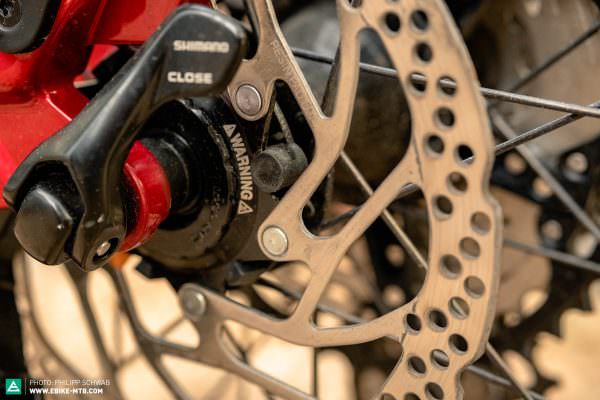
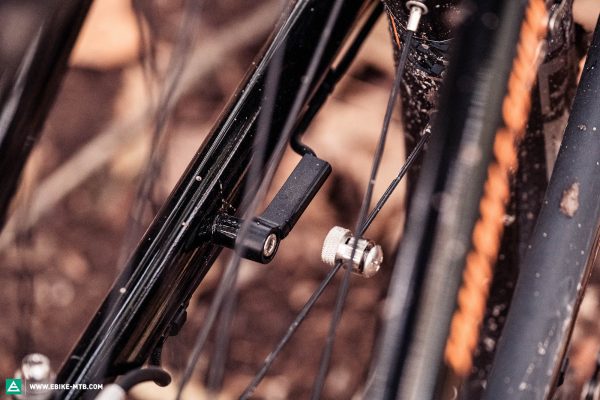
Weight
It’s difficult to compare the weight of the bikes in this test field. Some come with mudguards, a rack, side stand, lights or a lock and one even has rear suspension yet another is pretty much bare. To make it as fair as possible, we removed the locks before weighing, though we left the remaining accessories in place. Nevertheless, with an average weight of 26.78 kg, you won’t want to be carrying any of these bikes around very much.
Motor
With the motor, it’s not the maximum torque or the maximum power output that counts, but the ride feel and software settings. Some motors feel very natural in their assistance and are easy to control, while others require you to tread carefully on the pedals and find the right cadence. Smart and progressive support modes, such as Bosch’s eMTB mode or Shimano’s Trail mode, automatically regulate the motor based on rider input, eliminating the need to switch between support modes to suit the terrain. As a result, you’re able to concentrate fully on the trail in front of you and even have to shift gears less often. Unfortunately, some brands that rely on Bosch motors have opted against the option of eMTB and Sport mode. We recommend having eMTB mode installed at your local dealership via a software update. This update has been available for the powerful Performance Line CX motor for a long time, but it will only work for the trekking-oriented Performance Line model from 2020 onwards. With Shimano and Brose, you can adjust the motor to suit your personal preference via their respective apps. Unfortunately, this isn’t possible with Bosch but thanks to their smart eMTB mode, it isn’t really necessary either. For further information about the individual motors click here.
Tires
Knobbly tires alone don’t turn a step-through ebike into an eMTB. Nevertheless, tires are crucial in determining comfort, grip, range, safety and ride feel. Comfort mainly comes down to volume: we recommend tires between 2.35”-2.4” wide and the lowest tire pressure you can ride without risking punctures. On a step-through eMTB, it’s important to have tires with a rubber compound as well as a tread profile suitable for changing terrain and weather conditions and there are some huge disparities in our test. The Schwalbe Rock Razor, as found on the Riese & Müller, would make some of the other step-through eMTBs on test a lot more capable, while the Continental Race King tires on the Corratec couldn’t deliver on damp asphalt due to the hard, rubber compound lacking grip. Everyone needs puncture protection and most tires in the test have a puncture protection layer to protect against nails and sharp objects.
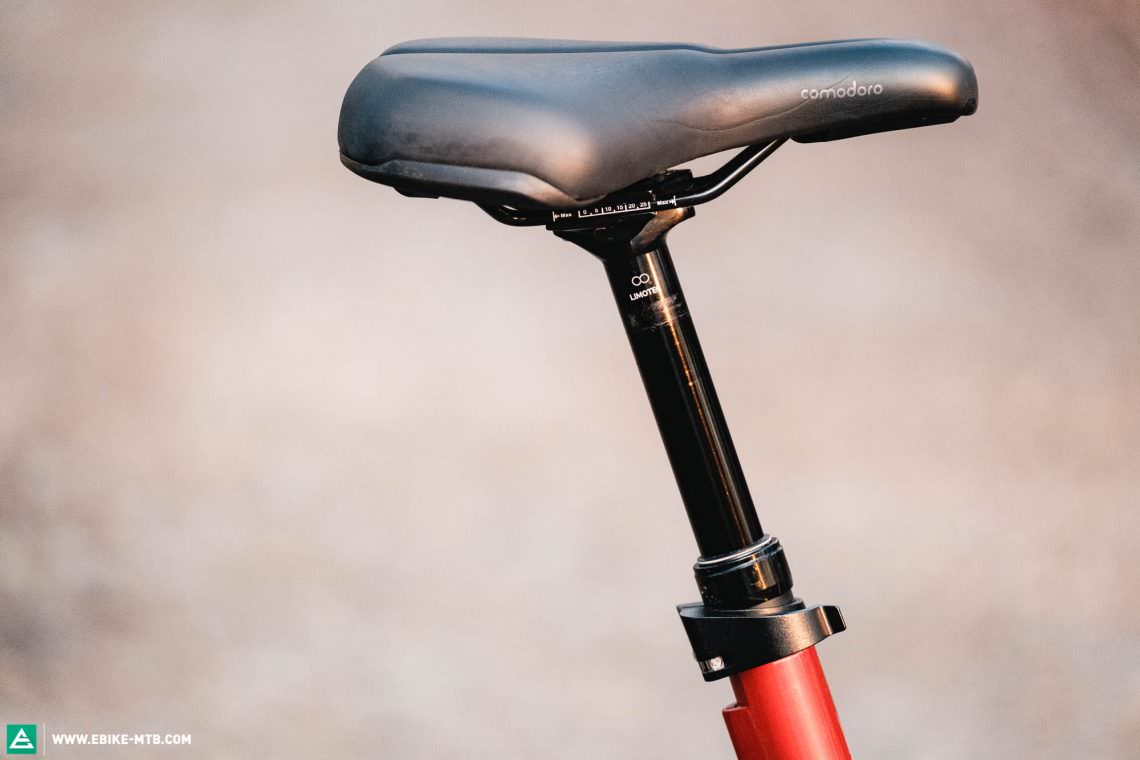
Seat post
Whether on the trail or at a traffic light: almost everyone benefits from a dropper post. This isn’t one of those unnecessary, high-tech MTB gadgets but a sensible solution offering real gains in comfort. Not only does it give you increased freedom of movement on the descents but it also ensures that you can get your foot on the ground easily and quickly without having to get off the saddle. Besides that, it makes sharing the bike with several riders a lot easier, allowing the saddle height to be adjusted quickly and easily. While most seat posts in the group test feature integrated suspension, only a few come specced with a dropper post. The CENTURION and KETTLER lead the way with combined suspension/dropper posts, giving you comfort and safety in one.
Side stands
On some step-through eMTBs, the side stand produces a deafening rattle on the trail and also folds out of its own accord on moderate terrain – a definite no-go! This can be really dangerous. Fortunately, you can fit a stiffer spring or a new stand with little cost. HNF-NICOLAI position the side stand on their UD3 step-through eMTB close to the bottom bracket. Although this makes the bike stand very securely, it gets in the way of the pedal when you try to push the bike. This is annoying if you just quickly want to move it around.
Anti-theft protection and GPS trackers
Those who plan to use their step-through eMTB in an urban environment stand to benefit from anti-theft protection that goes beyond a classic lock and a secure parking space. A GPS tracker is easy to retrofit to almost any ebike and offers added peace of mind over a conventional lock. We can recommend the PowUnity BikeTrax for € 199.90. BULLS have the option of a factory-fitted GPS tracker in the 750 Wh version of their step-through eMTB, allowing you to track your eMTB in the event of a theft for an additional € 199.
Riese & Müller probably offer the most comprehensive solution in the industry, the RX-Connect package, which consists of GPS tracker, eSIM and insurance. If your ebike gets stolen, you simply call the hotline or report the theft online, have your bike located and wait for it to be returned. Failing this, Riese & Müller will provide you with a new bike, provided that you’ve opted for insurance cover. You also have the option of additional services such as automatic wireless updates, crash detection and displaying where the bike is parked. The RX chip has a one-off cost of € 99 and the RX service package including insurance cover starts at € 139.90 per year.
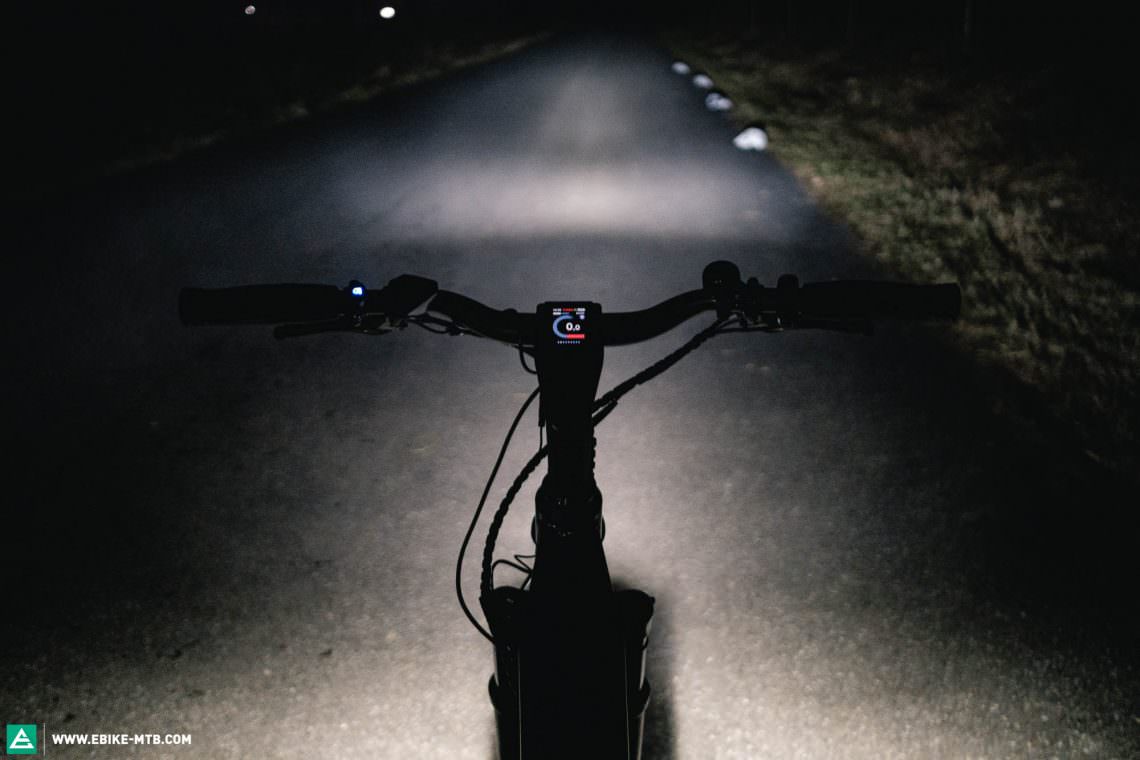
Lights
If you want to use your step-through eMTB all year round and frequently ride at night, you’ll want a good set of lights. The position of the lights is equally important. If the headlight is mounted centrally on the handlebar, mounting a basket will interfere with the light. If it is placed directly above the mudguard, it’ll cast a shadow right in front of the bike. If the light is mounted on the head tube, it doesn’t follow the direction that you’re turning. The good news is that all the lights we encountered in the test have more than enough output to be seen better at dusk. However, there are clear differences in how the light beam is shaped. The Supernova M99 Mini on the Riese & Müller as well as the Supernova Mini 2 on the HNF-NICOLAI are unrivalled in the test field – both turn night into day and you’ll be able to spot a mouse crossing your path 50 m ahead. The Supernova M99 Mini even has a high beam function that can be operated via a remote on the handlebar. The lights on the CENTURION and Moustache are acceptable but all others will have you struggling to see everything in the dark.
Permissible total weight and maximum payload
Like with cars, eMTBs have a limited permissible total weight. This weight is specified by the brands themselves and ensures that all the components on the bike are able to withstand the quoted load. The permissible total weight is the maximum weight the bike can carry, including the weight of the bike itself. The maximum payload, describes the additional load, such as rider (including all gear) and trailers, without including the weight of the bike. Of course, the permissible total weight and maximum payload also depend on what the bike is approved for. Can you use it on woodland paths? Is jumping officially allowed? Does the manufacturer approve using the bike on flow trails? Some bikes in the test field still have a very low maximum payload, where most riders would technically have to ride the bike in their underwear – the HNF-NICOLAI UD3 is limited to just 92 kg! The 101 kg maximum payload of the BULLS E-STREAM EVO 1 Wave 27.5 isn’t all that much either but you’re officially allowed to hit jumps up to 61 cm – you can’t do this on any other bike in the test field. Many brands are currently working to increase weight limits, but beware, some manufacturers in the test field have lost touch with reality. Just because components are able to carry a certain load, it doesn’t guarantee that they’ll still be able to perform as intended. The best example is the frame of the Corratec Life CX 6X Connect, which is certified to carry a load of up to 154 kg, corresponding to a permissible total weight of 180 kg. The bike already suffers vague handling with a rider weight of 85 kg. Load up the rack and it becomes hard to control and has a propensity for speed wobble. We’d like to see a permissible total weight of 150 kg being set as the new standard for the future, especially since many riders want to pull a trailer to take along their pets or children, which also get added to the payload. We advise heavier riders in particular to inform themselves about the maximum payload of a specific bike before buying. If you exceed the payload, this can have an impact on your safety, not to mention warranty claims.
Tops
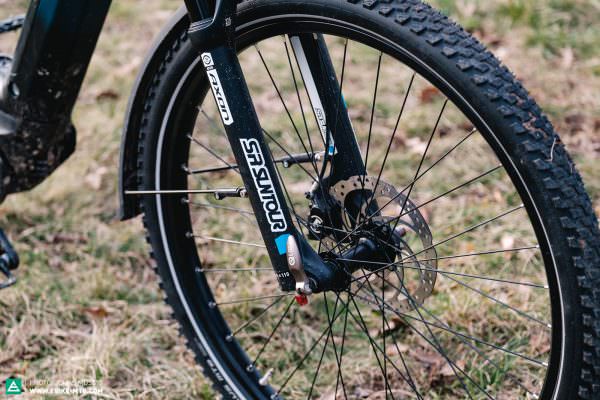
The Suntour Axon fork on the INFRONT is easy to adjust to the weight of the rider. It responds sensitively and delivers the best performance in the test.
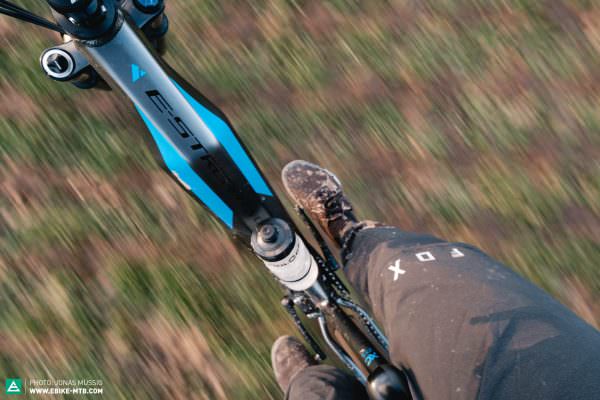
The handling and precision of the BULLS, CENTURION and Riese & Müller feel much better than any other bike in the test. This instils you with confidence and ensures predictable handling with luggage on the rear rack.
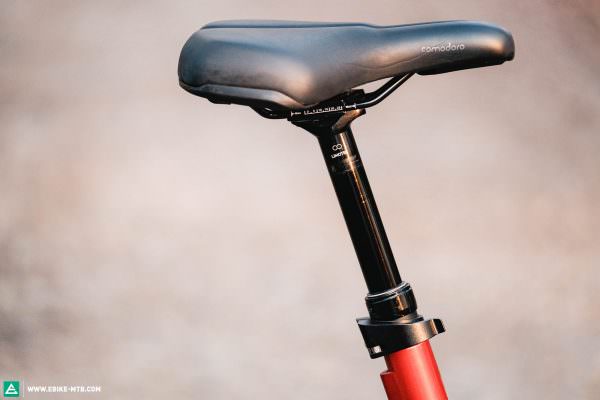
A dropper seat post with integrated suspension increases comfort, freedom of movement and safety. KETTLER and CENTURION are a step ahead of the competition here.
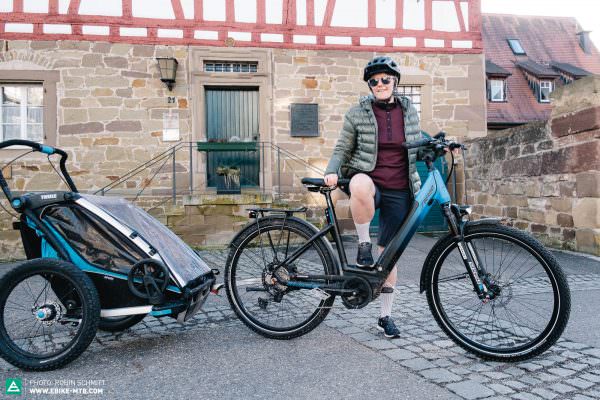
Fans of trailers will be delighted. All step-through ebikes in the test are approved to pull a trailer – with the exception of the FANTIC.

The Supernova M99 MINI light on the Riese & Müller turns night into day and even has a high beam function. What more do you want?

Riese & Müller’s full-suspension step-through eMTB is the most comfortable model in the test.

Riese & Müller’s RX Connect concept is a taste of things to come. The security concept combining a GPS tracker, eSIM and insurance cover is sure to fend off ebike thieves.
Flops
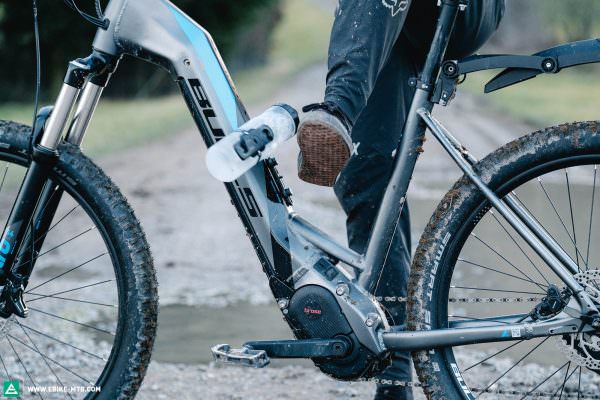
Is a step-through bike still a step-through bike if the water bottle blocks the step-through section of the frame? BULLS, Moustache and KETTLER restrict the easy entry of their bikes with the position of the bottle cage bosses.
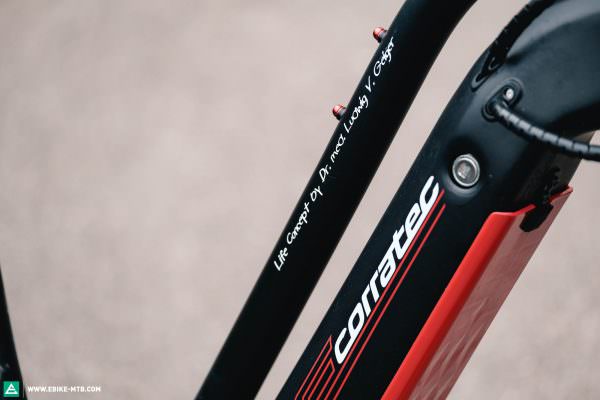
The twin down tube together with the 180 kg permissible total weight suggests stability. However, it turns out that the Corratec has the most indirect and vague handling in the test. The bike became difficult to control long before we reached the maximum payload.
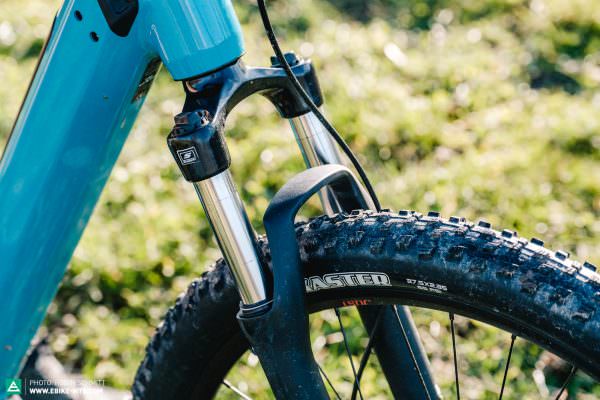
With the Moustache, KETTLER, FANTIC and Corratec, the forks can’t be adjusted sufficiently to suit the weight of the rider, rendering them useless for many users.

Most brakes in the test are too weak and prone to fade on the descents, especially when you’re carrying luggage. The worst are on the Corratec, HNF-NICOLAI and Riese & Müller.

A small gear range combined with the weaker Bosch Performance Line motor means that the Moustache soon reaches its limit on steep climbs. The same applies to the FANTIC.
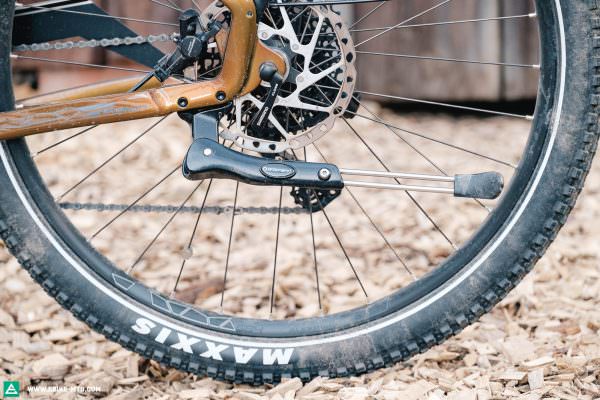
A side stand that unfolds itself on moderate off-road terrain can become dangerous. Fortunately, an upgrade is quick and inexpensive, which is what you should do on the CENTURION.
The best step-through eMTB of 2020 – CENTURION E-Fire Country F3500
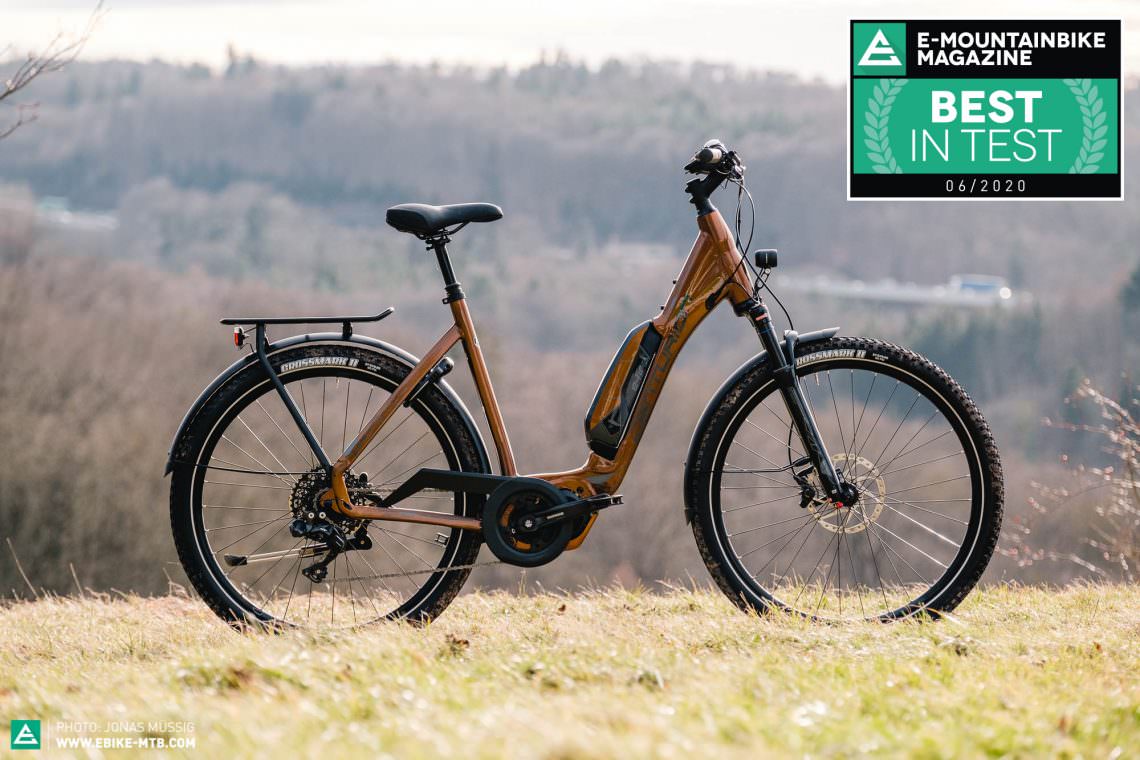
Price € 3,999 | Weight: 23,7 kg (Size L) | More information www.centurion.de
The CENTURION E-Fire Country F3500 is the deserved Best in Test of this big group test! What makes it so good? Admittedly, the E-Fire Country F3500 isn’t the most stylish looking bike in the test field, but it is by far the best all-rounder with the widest range of applications. The battery isn’t fully integrated in order to make the frame as stiff as possible. This ensures precise and predictable handling while also instilling you with confidence, regardless of the situation. With or without luggage, the bike performs equally well in city traffic and on long tours and offers a comfortable riding position. It’s a lot of fun on forest and woodland paths as well as moderate trails! The componentry is impeccable, of which the dropper post with integrated suspension is a particular highlight. Thanks to the consistent overall concept, great all-round capabilities and the excellent performance, the CENTURION E-Fire Country F3500 is the deserved Best in Test and the best step-through eMTB of 2020!
Click here for the full review of the CENTURION E-Fire Country F3500
The E-MOUNTAINBIKE Best Buy – BULLS E-STREAM EVO 1 WAVE 27.5+
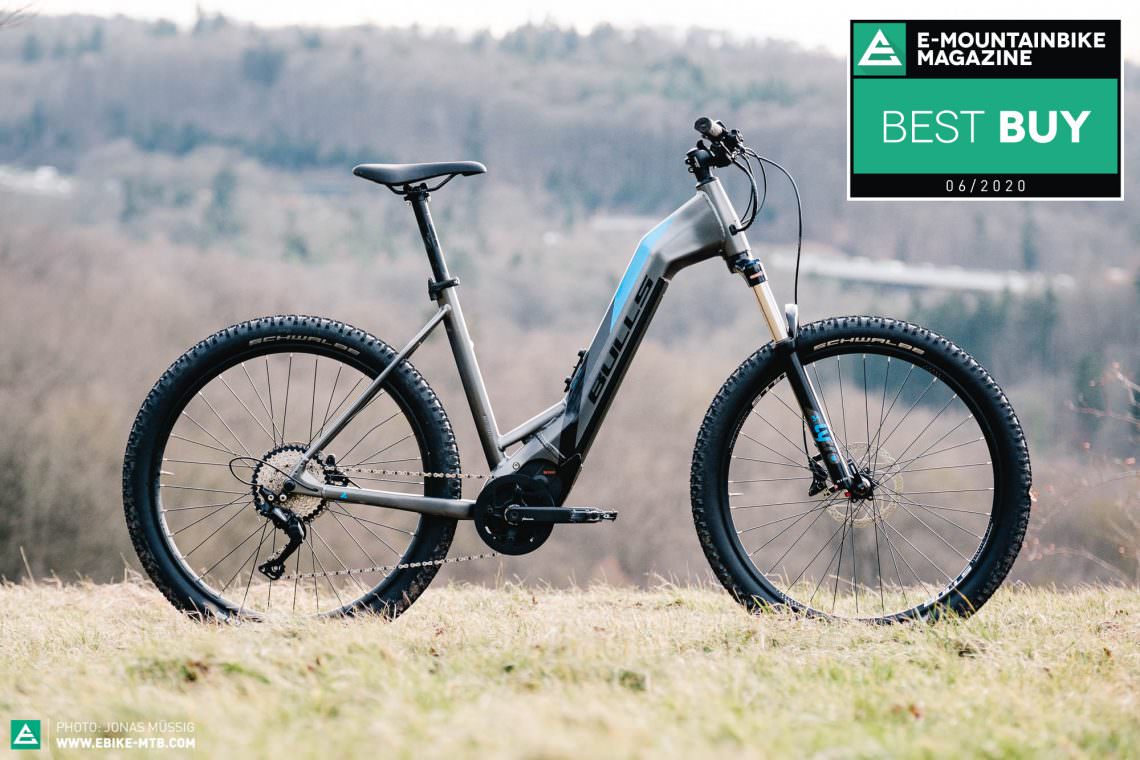
Price € 3,599 | Weight 23.8 kg (Size L) | More information www.bulls.de
The BULLS E-STREAM EVO 1 WAVE 27.5+ blew away even the most hardcore eMTBers in our test crew. In terms of handling and trail performance, the BULLS is in no way inferior to a hardtail eMTB, with the added bonus that you’ve got even more freedom of movement thanks to the missing top tube! The intuitive handling, coupled with plenty of comfort on long tours and good climbing characteristics, makes it a versatile option for moderate off-road terrain. A better suspension fork and a dropper post would make it even more capable on the trails. However, given the relatively affordable price of € 3,599, the spec is acceptable. The BULLS comes without any additional accessories such as lights, mudguards or luggage racks. However, thanks to the elegantly integrated Monkey Link system, fitting mudguards or lights is a breeze – clip them on and you’re good to go! And go you will, since the BULLS E-STREAM EVO 1 WAVE 27.5+ is equipped with the extremely powerful 90 Nm Brose Drive S Mag motor powered by a huge 750 Wh battery. No other model in the test field comes as close to the feel and handling of a traditional eMTB hardtail as the BULLS E-STREAM EVO 1 WAVE 27.5+ – pure riding pleasure and a great choice for more aggressive riders! Hands down, the Best Buy!
Click here for the full review of BULLS E-STREAM EVO 1 WAVE 27.5+
Other step-through eMTBs worth mentioning
While the CENTURION E-Fire Country F3500 is the best all-rounder, there are a few other eMTBs in the test field worth mentioning. There’s no such thing as the perfect bike for everyone, but everyone will find a perfect bike for them. The question you should ask yourselves:: where and how will you use the step-through ebike? What does it have to be able to do?
Riese & Müller Homage GT Rohloff GX
Price € 6,499 | Weight 29.7 kg (Size M) | More information www.r-m.de
The Riese & Müller Homage GT Rohloff GX is unique in many ways. It is the only full suspension step-through ebike on the market and it’s the only bike on test with a dual-battery option and the comprehensive RX Connect security concept that features GPS tracking and premium insurance coverage. Thanks to the rear suspension, the level of comfort and traction is unrivalled. Especially for off-road commuters and touring enthusiasts, the stable handling of the Homage GT is a good option. The rear carrier forms part of the bike’s sprung mass, which is why the Riese & Müller is one of the most stable and composed step-through eMTBs to ride with panniers. With the best lights in the test and the innovative RX Connect anti-theft system, it performs just as well in an urban environment. With the exception of the brakes, the componentry is very robust. However, that comes at a price: the Riese & Müller Homage GT Rohloff GX weighs 29.7 kg. If you like innovative features and are looking for a composed step-through eMTB, you should definitely take a closer look at the Riese & Müller Homage GT.
Click here for the full review of Riese & Müller Homage GT Rohloff GX
INFRONT IF-4 Wave
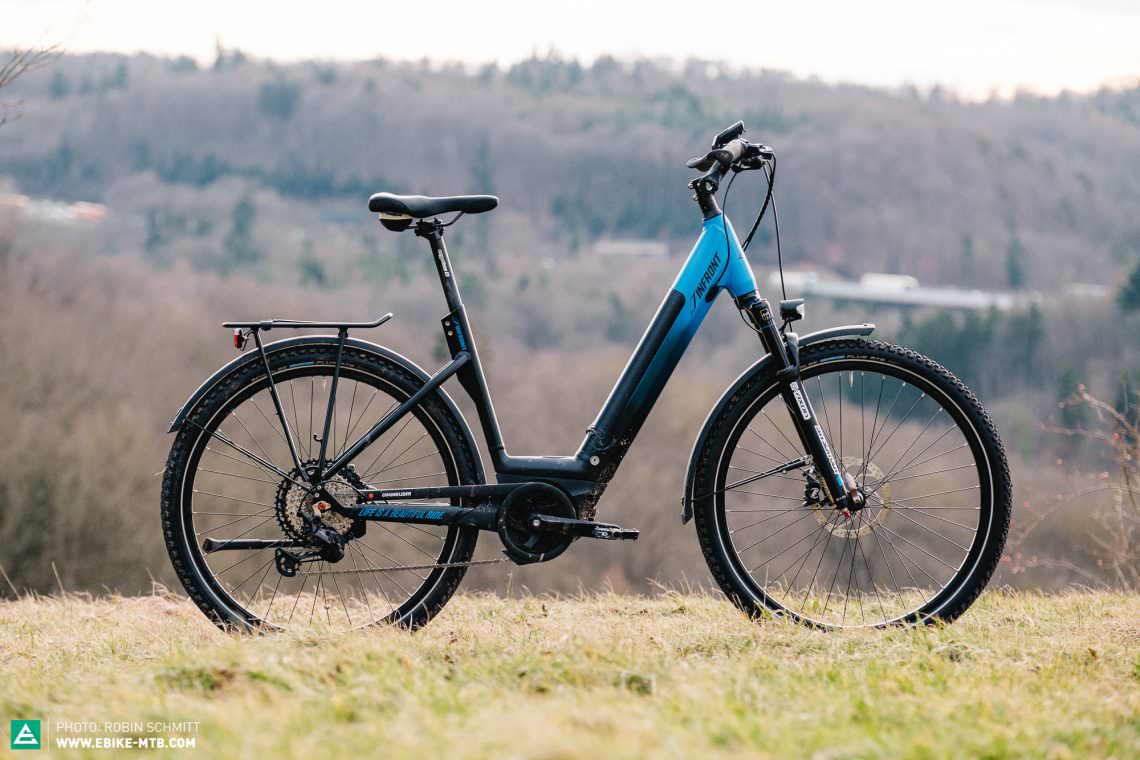
Price € 3,599 | Weight 27.1 kg (Size L) | More information www.infront-bikes.com
The step-through eMTB from small bike brand, INFRONT, is called the IF-4 Wave and it surprised our test crew! It is one of the most versatile step-through eMTBs in the test, performing just as well as an everyday commuter as it does on tours and moderate off-road terrain. It goes exactly where you point it and instils you with confidence, not least because of the tall front end, the best fork in the test and excellent brakes. The wide saddle restricts your freedom of movement on the trails and an aftermarket dropper post would make you feel more confident and make the bike significantly more versatile.
Click here for the full review of INFRONT IF-4 wave
Kalkhoff Entice 5.B Excite
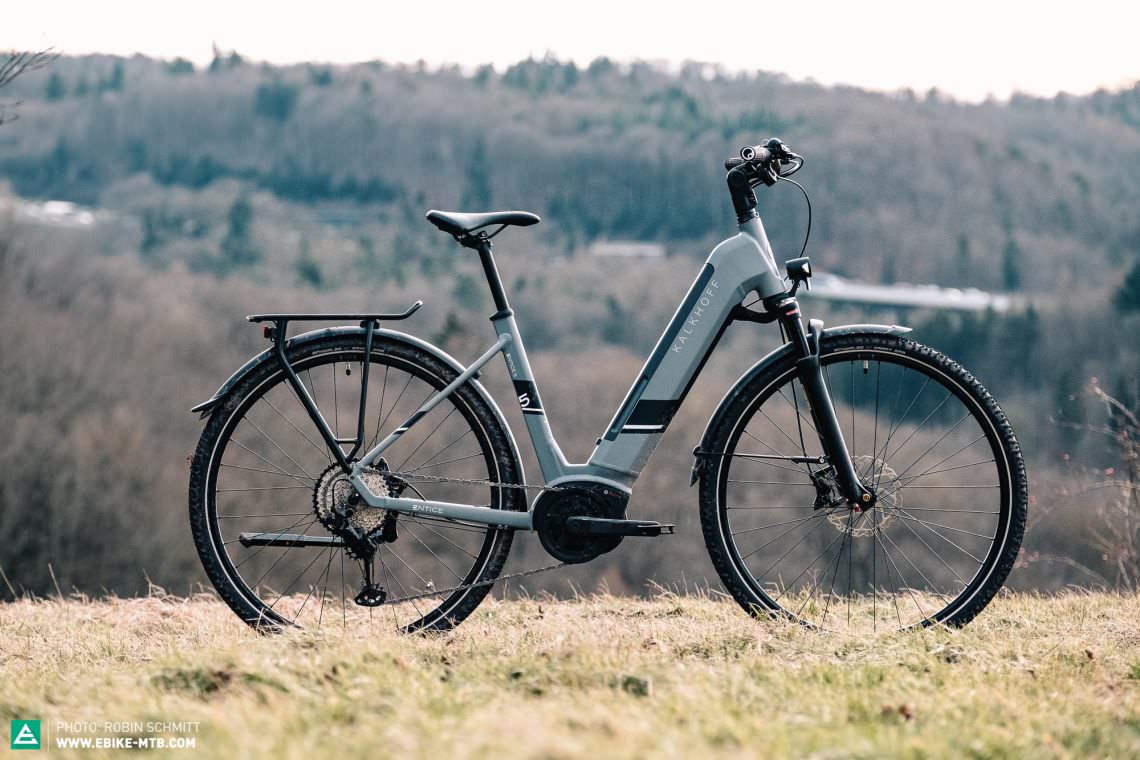
Price € 3,699 | Weight 24.8 kg (Size M) | More information www.kalkhoff-bikes.com
You’re looking for a stylish step-through ebike to cruise through the city? Then the Kalkhoff Entice 5.B Excite is definitely worth considering with its elegant yet sporty look. Thanks to its precise and agile character, it’s a ton of fun to ride in the urban jungle. At the same time, the bike’s handling is intuitive, making it great for beginners and advanced riders alike. However, it’s no pack mule, not to mention the lack of comfort. Those who want to go touring or tend to ride off-road will have to keep looking. The Kalkhoff is a bike for the urban environment.
Click here for the full review of Kalkhoff Entice 5.B Excite
All bikes in test:
BULLS E-STREAM EVO 1 WAVE 27,5+ | CENTURION E-Fire Country F3500 | Corratec Life CX 6X Connect | FANTIC ISSIMO FUN | HNF-NICOLAI UD 3 | INFRONT IF-4 Wave | Kalkhoff Entice 5.B Excite | KETTLER QUADRIGA TOWN & COUNTRY COMP | Moustache Samedi 27 Off 2 Open | Riese & Müller Homage GT
The role of eMTBs and the potential for where they can be used are changing rapidly. We offer fresh impetus to that change while helping to maintain a clear overview. One thing is for sure: the future of the eMTB is more exciting than ever before! Our E-MOUNTAINBIKE Theory of Evolution provides context for this and all other articles in our New Generation series, providing new perspectives and broadening the horizon of what’s ahead.
Further articles in the series cover the era of E-SUVs, the new handling of Light eMTBs, the potential for off-road cargo bikes, our off-road step-through group test, connectivity and software solutions, the new generation Z and our guide to passing on your bike passion to your kids.
Did you enjoy this article? If so, we would be stoked if you decide to support us with a monthly contribution. By becoming a supporter of E-MOUNTAINBIKE, you will help secure a sustainable future for high-quality cycling journalism. Click here to learn more.
Words: Photos: Robin Schmitt, Jonas Müssig, Philipp Schwab








